Table of Contents
What is an Adductor Muscle Strain?
An adductor muscle strain is characterized as an acute injury to the muscles of the groin. Although a variety of muscles in the human body can be injured, the adductor longus, medius, magnus, and the gracilis are some of the most well-known muscle groups to be affected by an injury. Strains are muscle tears which generally occur due to the powerful contraction of the muscles against resistance, often during what is referred to as an eccentric load. Â
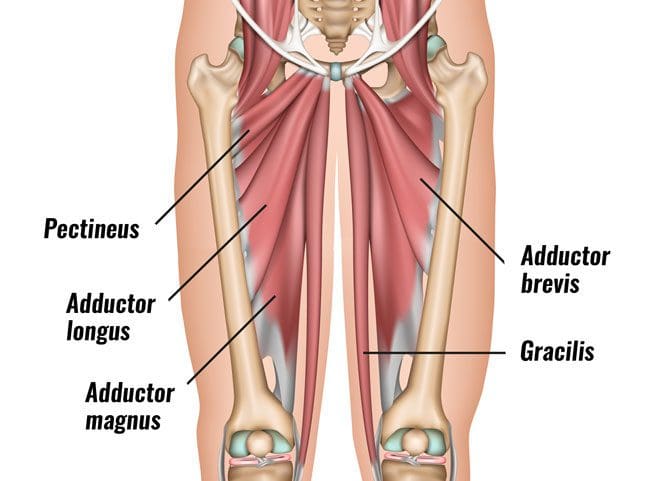 Â
Â
An eccentric load describes some muscle contraction while the muscle is lengthening, versus concentric, where the muscle is shortening during some muscle contraction. Most weight-lifting exercises and physical activities involve concentric contraction. By way of instance, bench press involves eccentric contraction. Moreover, tears can occur at the origin of the muscle, at the muscle-tendon junction, or inside the belly of the muscle(s). Tears most frequently happen at the muscle-tendon junction. The least common tendon injury occurs at the region of its bony attachment. Â
Adductor muscle strains may be graded I-III depending upon their seriousness. A grade I injury involves a moderate strain with some pain and discomfort, tenderness, and bleeding, but no fiber disruption. The adductor muscle’s overall integrity is maintained although a Grade II injury involves further damage. A grade III injury involves disruption resulting in a loss of tendon integrity. Most adductor muscle strains are considered to be grade I or II injuries. Â
Causes and Symptoms of an Adductor Strain
As previously mentioned above, an adductor muscle strain occurs during acute muscle contraction, such as during kicking, pivoting or skating. Factors which can predispose a person to injury include failure to properly stretch or warm up and fatigue from overuse. The risk of experiencing an adductor strain increases with sports involving strides like sprinting, soccer, and hockey. Sports with repeated movements like football, martial arts, and gymnastics can also substantially increase the risk of experiencing an adductor strain. Struggling to warm up, stretch or be properly conditioned can also cause injury. Â
The symptoms associated with an adductor muscle strain most commonly involve a variety of painful symptoms which are most frequently related to other types of muscle strain. Common symptoms of an adductor muscle strain include a sudden onset of pain and discomfort, occasionally accompanied by the feeling of a pop in the inner section of the thigh as well as the inability to maintain action after the first onset of painful symptoms. Because an adductor strain may cause groin or hip pain, many patients and healthcare professionals may confuse this type of injury with sciatica or sciatic nerve pain. Â
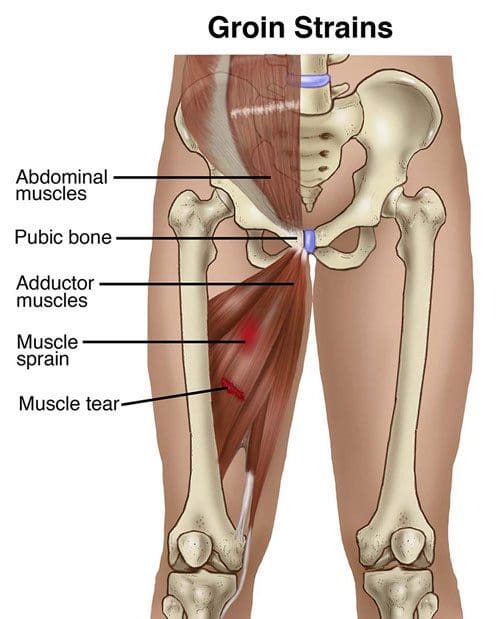 Â
Â
Diagnosis and Treatment for an Adductor Strain
A healthcare professional can diagnose an adductor muscle strain through the patient’s medical history and a physical evaluation. Clinical findings include tenderness to palpation or touch, bruising through the inner thigh, as well as swelling and heat within the region of the injury. With acute tears, there might be a palpable defect over the area of the injury. Motion testing of the hip is normal, however, pain generally occurs while the patient is asked to contract the muscles. In these cases, asking the patient to bring their leg towards midline can ultimately cause pain and is generally accompanied by weakness. Â
X-rays are often not utilized to diagnose an adductor muscle strain, however, they are appropriate in instances in which there are tenderness at the site of bony insertion or in young patients and/or athletes. In children, the attachment sites of a muscle and/or tendon are weaker and vulnerable to fracture. MRI can provide the precise location of an injury and the extent might help estimate return to play, or in rare cases, help identify any other cases which may require surgical interventions. Â
Many adductor muscle strains respond positively to conservative treatment. The utilization of ice therapy and anti-inflammatory medicine are appropriate for acute muscle strains. As symptoms improve, stretching and exercises are generally not recommended. The healthcare professional may suggest a physical therapy program. Surgery may be required for adductor muscle tendon tears. Repair entails an open incision within the site of injury and reattachment of the tendon. Surgery is also essential in patients who have chronic pain whose symptoms don’t respond to conservative therapy. Â
What is Adductor Tendinopathy?
Adductor tendinopathy is generally characterized as pain on palpation of the adductor tendons, adduction of the legs and/or of the injured leg. Pain can develop gradually or cause a sudden and severe, sharp pain. A swelling or a lump may also be experienced from the adductor muscle(s), stiffness at the groin area or an inability to contract or extend the adductors. In acute cases, exercises and physical activities will be restricted because the tendon can’t sustain repeated tensile loading. Â
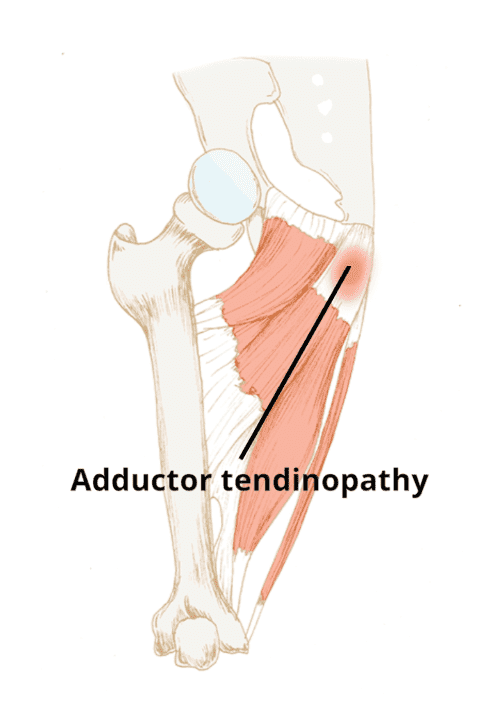 Â
Â
Causes and Symptoms of Adductor Tendinopathy
The adductors are triggered in many sports such as, running, soccer, horse riding, gymnastics, and swimming. The repetitive movements and the continuous change of direction in physical activities activate the adductor tendon, which makes athletes more prevalent to develop adductor tendinopathy and other groin injuries. Other causes of adductor tendinopathy can include over-stretching of the adductor tendons or a sudden increase in training, especially in the type of training. Â
Adductor tendinopathy may occur due to considerable leg length discrepancy which affects gait pattern. Poor or abnormal movement patterns may also overly stress the adductor tendons. Muscular length gaps, strength imbalances or muscular weakness in the thoracic or the abdominals can also be powerful in developing adductor tendinopathy. Other causes include a failure to properly warm-up, inactivity, fatigue, obesity, age-related weaknesses, genetics or degeneration. Â
Diagnosis and Treatment for Adductor Tendinopathy
A healthcare professional can safely and effectively develop an appropriate treatment plan following a thorough diagnosis or further investigations could be undertaken, including ultrasound, MRI or CT scans. Achieving pain relief through the utilization of NSAIDs may be ineffective due to the non-inflammatory nature of the injury. Steroid injections are also not necessarily recommended due to potential tendon rupture if these are injected directly into the tendon. Â
Physical therapy is often recommended for the treatment of adductor tendinopathy, although there’s no golden standard for the proper rehabilitation of the adductor tendon. Recovery is extremely variable across individuals because the injury may be degenerative or even due to previously failed healing. Strengthening exercises and physical activities are also recommended to promote proper healing. Treatment should be customized to the patient to avoid recurrence. Â
Other treatment for adductor tendinopathy generally consists of avoiding exercise or physical activity in the first 48 hours. The patient should then apply the RICE treatment three times per day for 10-20 minutes to help reduce swelling and inflammation from any sudden trauma. If the painful symptoms have decreased, blood flow stimulation therapy could be started to help promote the healing process. Active treatment is subsequently suggested to follow up with rehabilitation. Â
Furthermore, the goal of rehabilitation is to restore the adductor muscle and tendon properties where strength training is beneficial to the adductor structure, muscle building, and biomechanics. Recent research studies have also demonstrated that an eccentric based exercise program is the most effective as well as heavy-slow eccentric and concentric exercises for enhancing both function and symptoms. For effective treatment identifying the stage of the tendinopathy is also essential.
Differential Diagnosis of Hip Pain and Discomfort
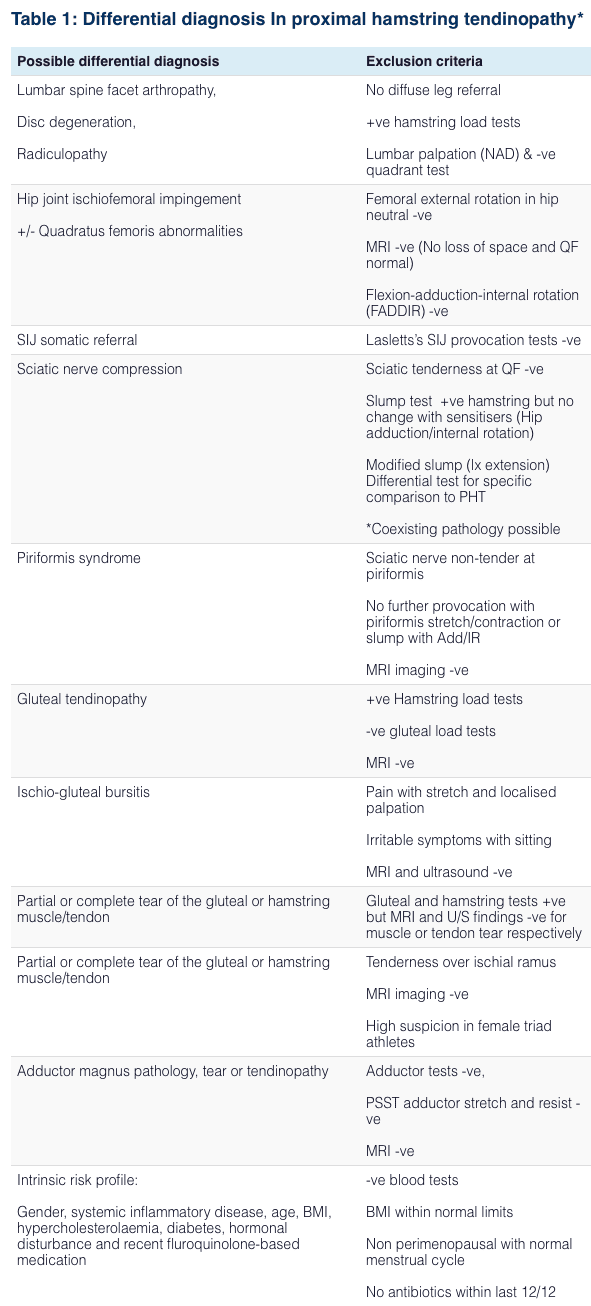 Â
 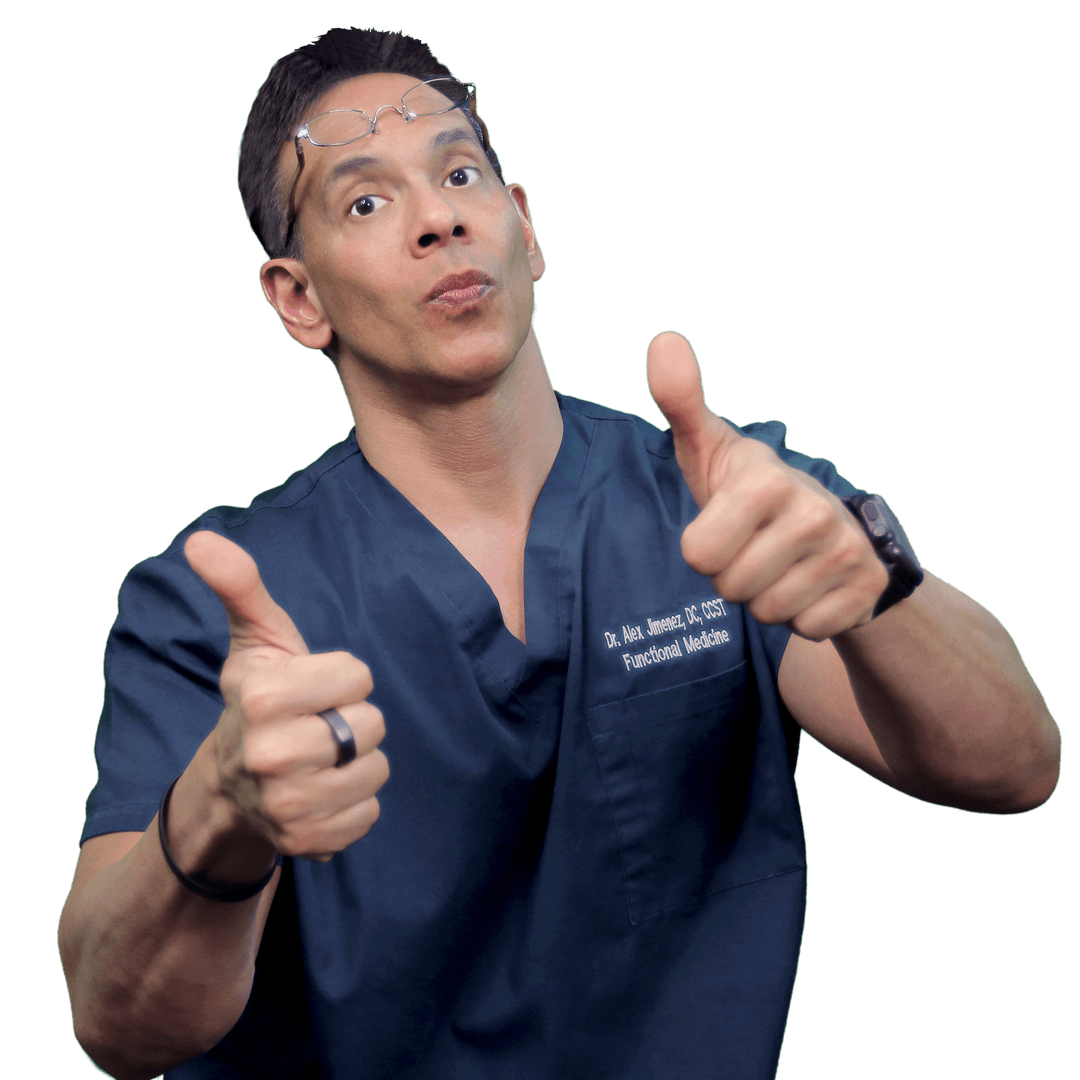
Most commonly well-known as a groin strain, an adductor muscle strain is a type of injury which affects one of a group of muscles found at the top of the thigh. Meanwhile, adductor tendinopathy can affect the tendons of the adductor muscles. Both of these type of injuries can ultimately cause a variety of painful symptoms and they generally require time to heal properly. Because of the location of the injury, many patients and healthcare professionals may confuse groin injuries with sciatica without proper diagnosis. Proper diagnosis is essential to follow-up with proper treatment. – Dr. Alex Jimenez D.C., C.C.S.T. Insight
Fibromyalgia Magazine
The purpose of the article was to discuss adductor muscle strain, tendinopathy, and sciatica. It has also been observed that patients with adductor injuries may confuse their symptoms for sciatica. The scope of our information is limited to chiropractic, musculoskeletal and nervous health issues as well as functional medicine articles, topics, and discussions. To further discuss the subject matter above, please feel free to ask Dr. Alex Jimenez or contact us at 915-850-0900 . Â
Curated by Dr. Alex Jimenez Â
Additional Topic Discussion: Severe Sciatica
Back pain is one of the most prevalent causes of disability and missed days at work worldwide. Back pain attributes to the second most common reason for doctor office visits, outnumbered only by upper-respiratory infections. Approximately 80 percent of the population will experience back pain at least once throughout their life. Your spine is a complex structure made up of bones, joints, ligaments, and muscles, among other soft tissues. Injuries and/or aggravated conditions, such as herniated discs, can eventually lead to symptoms of sciatica, or sciatic nerve pain. Sports injuries or automobile accident injuries are often the most frequent cause of painful symptoms, however, sometimes the simplest of movements can have these results. Fortunately, alternative treatment options, such as chiropractic care, can help ease sciatic nerve pain, or sciatica, through the utilization of spinal adjustments and manual manipulations, ultimately improving pain relief. Â
Formulas for Methylation Support
XYMOGEN’s Exclusive Professional Formulas are available through select licensed health care professionals. The internet sale and discounting of XYMOGEN formulas are strictly prohibited.
Proudly, Dr. Alexander Jimenez makes XYMOGEN formulas available only to patients under our care.
Please call our office in order for us to assign a doctor consultation for immediate access.
If you are a patient of Injury Medical & Chiropractic Clinic, you may inquire about XYMOGEN by calling 915-850-0900.
For your convenience and review of the XYMOGEN products please review the following link.*XYMOGEN-Catalog-Download Â
* All of the above XYMOGEN policies remain strictly in force. Â
Â
Post Disclaimer
Professional Scope of Practice *
The information herein on "Adductor Strain, Tendinopathy, and Sciatica" is not intended to replace a one-on-one relationship with a qualified health care professional or licensed physician and is not medical advice. We encourage you to make healthcare decisions based on your research and partnership with a qualified healthcare professional.
Blog Information & Scope Discussions
Welcome to El Paso's Premier Wellness, Personal Injury Care Clinic & Wellness Blog, where Dr. Alex Jimenez, DC, FNP-C, a Multi-State board-certified Family Practice Nurse Practitioner (FNP-BC) and Chiropractor (DC), presents insights on how our multidisciplinary team is dedicated to holistic healing and personalized care. Our practice aligns with evidence-based treatment protocols inspired by integrative medicine principles, similar to those found on this site and our family practice-based chiromed.com site, focusing on restoring health naturally for patients of all ages.
Our areas of multidisciplinary practice include Wellness & Nutrition, Chronic Pain, Personal Injury, Auto Accident Care, Work Injuries, Back Injury, Low Back Pain, Neck Pain, Migraine Headaches, Sports Injuries, Severe Sciatica, Scoliosis, Complex Herniated Discs, Fibromyalgia, Chronic Pain, Complex Injuries, Stress Management, Functional Medicine Treatments, and in-scope care protocols.
Our information scope is multidisciplinary, focusing on musculoskeletal and physical medicine, wellness, contributing etiological viscerosomatic disturbances within clinical presentations, associated somato-visceral reflex clinical dynamics, subluxation complexes, sensitive health issues, and functional medicine articles, topics, and discussions.
We provide and present clinical collaboration with specialists from various disciplines. Each specialist is governed by their professional scope of practice and their jurisdiction of licensure. We use functional health & wellness protocols to treat and support care for musculoskeletal injuries or disorders.
Our videos, posts, topics, and insights address clinical matters and issues that are directly or indirectly related to our clinical scope of practice.
Our office has made a reasonable effort to provide supportive citations and has identified relevant research studies that support our posts. We provide copies of supporting research studies upon request to regulatory boards and the public.
We understand that we cover matters that require an additional explanation of how they may assist in a particular care plan or treatment protocol; therefore, to discuss the subject matter above further, please feel free to ask Dr. Alex Jimenez, DC, APRN, FNP-BC, or contact us at 915-850-0900.
We are here to help you and your family.
Blessings
Dr. Alex Jimenez DC, MSACP, APRN, FNP-BC*, CCST, IFMCP, CFMP, ATN
email: coach@elpasofunctionalmedicine.com
Multidisciplinary Licensing & Board Certifications:
Licensed as a Doctor of Chiropractic (DC) in Texas & New Mexico*
Texas DC License #: TX5807, Verified: TX5807
New Mexico DC License #: NM-DC2182, Verified: NM-DC2182
Multi-State Advanced Practice Registered Nurse (APRN*) in Texas & Multi-States
Multistate Compact APRN License by Endorsement (42 States)
Texas APRN License #: 1191402, Verified: 1191402 *
Florida APRN License #: 11043890, Verified: APRN11043890 *
License Verification Link: Nursys License Verifier
* Prescriptive Authority Authorized
ANCC FNP-BC: Board Certified Nurse Practitioner*
Compact Status: Multi-State License: Authorized to Practice in 40 States*
Graduate with Honors: ICHS: MSN-FNP (Family Nurse Practitioner Program)
Degree Granted. Master's in Family Practice MSN Diploma (Cum Laude)
Dr. Alex Jimenez, DC, APRN, FNP-BC*, CFMP, IFMCP, ATN, CCST
My Digital Business Card
RN: Registered Nurse
APRNP: Advanced Practice Registered Nurse
FNP: Family Practice Specialization
DC: Doctor of Chiropractic
CFMP: Certified Functional Medicine Provider
MSN-FNP: Master of Science in Family Practice Medicine
MSACP: Master of Science in Advanced Clinical Practice
IFMCP: Institute of Functional Medicine
CCST: Certified Chiropractic Spinal Trauma
ATN: Advanced Translational Neutrogenomics


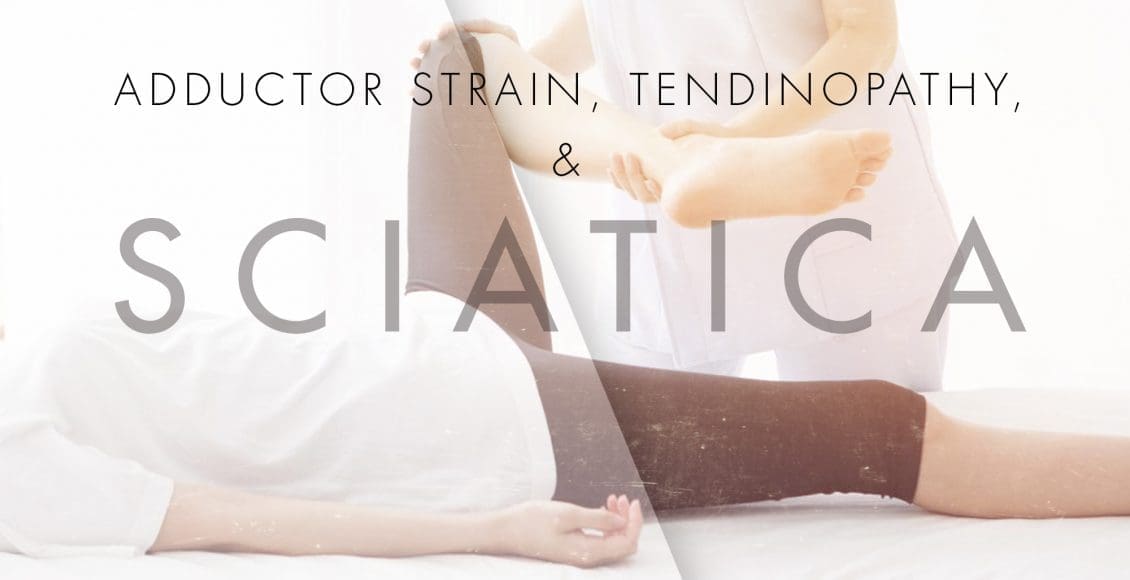
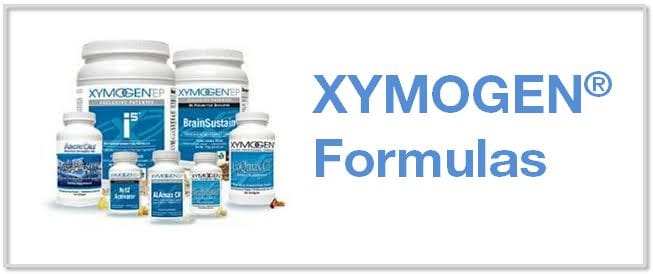
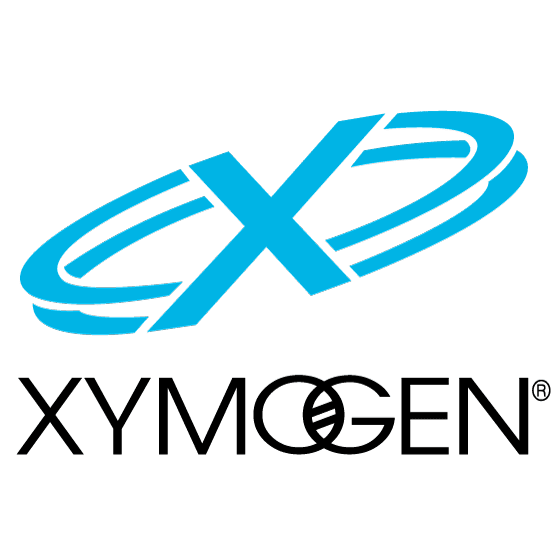


 Again, We Welcome You.
Again, We Welcome You.
Comments are closed.